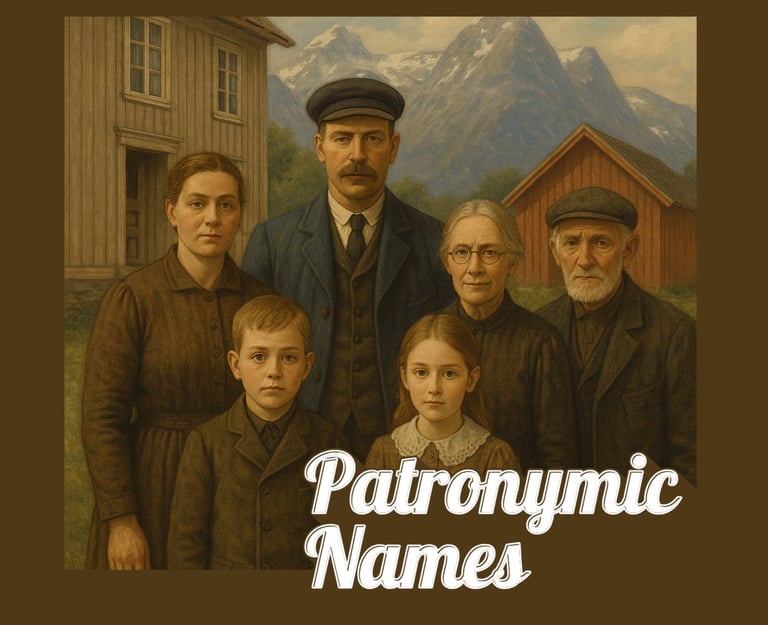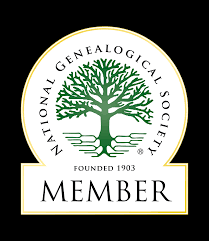Tracing Norwegian Roots: Understanding Patronymics, Farm Names, and Surname Shifts
If you've ever researched Norwegian ancestors and found surnames changing from one generation to the next, you're not alone. Traditional Norwegian naming customs can appear confusing at first glance, but they follow a fascinating and logical system rooted in patronymics and farm names. This article explores how surnames were formed from a father's first name, why farm names were often added, and how modernization eventually led to permanent family surnames. Whether you're a beginner or an experienced genealogist, understanding these naming patterns is essential to uncovering your Norwegian family history.
-Aimee Rose-Haynes
7/27/20253 min read


If you have Norwegian ancestors in your family tree, you may have noticed that their surnames often shift from one generation to the next. These changes are not random; they are rooted in a traditional naming system known as patronymics, which was widely used throughout Scandinavia.
What Is a Patronymic Surname?
A patronymic surname is created by taking a father’s first name and adding a suffix that identifies the child as his son or daughter. In Norway, sons would receive a surname ending in -sen or -son, while daughters would be given -datter or -dotter.
For example, if a man named Anders Larsen had two children named Olav and Astrid, their surnames would be Andersen and Andersdatter, respectively. When Olav had children of his own, they would become Olavsen or Olavdatter.
This system reflected a strong connection to family lineage and was not unique to Norway. Similar patronymic naming patterns were used across Sweden, Denmark, and Iceland. In fact, Iceland still uses a patronymic system today, while most of Scandinavia has transitioned to fixed surnames.
It is important to note that Norwegian women typically did not adopt their husband's surname upon marriage. Instead, they retained their birth surname throughout their life, which helps genealogists today trace female ancestors through generations more easily than in some other cultures.
The Role of Farm Names
As the population grew, especially in rural areas, patronymics alone were not always enough to distinguish between individuals. Towns could have several unrelated men named Nils Nilsen, making identification difficult in legal records, church books, and censuses.
To solve this issue, many Norwegians began adding farm names to their identity. These were not surnames in the modern sense but rather location identifiers. A farm name indicated the property or area where a person lived or worked. For example, three men named Lars Larsen might be distinguished as Lars Larsen Dal, Lars Larsen Vollen, and Lars Larsen Bekk based on the farms where they resided.
When a family moved to a different farm, their farm name would usually change as well. This means it is common to see a person listed with different surnames in different records, even though it is the same individual. Understanding this system is critical when conducting Norwegian genealogical research, as it helps avoid mistaking one ancestor for multiple people.
Transition to Permanent Surnames
By the mid-1800s, societal changes began to influence naming practices. Industrialization led to greater urbanization, and people moving into cities needed consistent identities for employment, legal matters, and property ownership. This shift led many Norwegians to begin using fixed surnames instead of changing them each generation.
By 1900, the practice of using permanent surnames was common across much of Norway. Then in 1923, the Norwegian government passed a law requiring families to choose a single surname to be passed down through generations. This law required everyone to register their surname with the authorities, establishing a formal record and preventing frequent name changes.
Families were given a choice: they could continue using their patronymic surname, such as Nilsen, even if it no longer reflected the father’s first name, or they could adopt a farm name as a hereditary surname. Some chose to maintain the traditional naming convention, while others opted for the familiarity and pride associated with a long-standing family farm.
Norwegian Surnames Today
Today, most Norwegian surnames reflect this legacy. Names ending in -sen like Pedersen, Andersen, and Eriksen are patronymic in origin, though they are now fixed family names. Farm names like Dal, Berg, or Vik also remain common and often reflect the geographical roots of the family.
For those tracing Norwegian ancestry, it is essential to understand these naming patterns. A surname that appears to "change" across generations may not signal a different family line but rather a continuation of traditional Norwegian naming customs.
By understanding the history of patronymics and farm names, researchers can better trace their ancestors, even when the names seem inconsistent. Norwegian surnames tell a story of both family and place... a connection that continues to echo through generations.




